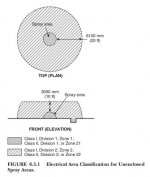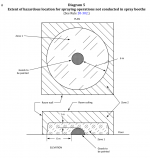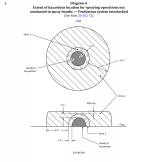I have a question about outdoor spraying. I'm working on a custom made blasting/coating robot but I want to be sure about the requirements for the equipment. I'm assuming all the servo motors on the machine will need to be Zone 1 explosion proof, but what about nearby electrical equipment (ie. the control panel)?
Referencing Canadian Electrical Code, 20-302 says that any spraying not conducted in spray booths has a Zone 1 area 6m around it, and a Zone 2 area to "the edges of the building". This could be reduced if there was "adequate ventilation with effective interlocks provided at floor level", so that the Zone 1 area is only 1m away from the spraying and the Zone 2 area is 6m.
What's the classification here for outdoor purposes? Can I assume that being outside is an effective interlock and use those limits? Does being outside derate it even more and I can use general purpose outdoor equipment? I'm not sure, any advice would be great.
Even if you aren't familiar with Canadian code, I would be happy to hear about the NEC, since there is a lot of overlap between the two. Thanks!
Referencing Canadian Electrical Code, 20-302 says that any spraying not conducted in spray booths has a Zone 1 area 6m around it, and a Zone 2 area to "the edges of the building". This could be reduced if there was "adequate ventilation with effective interlocks provided at floor level", so that the Zone 1 area is only 1m away from the spraying and the Zone 2 area is 6m.
What's the classification here for outdoor purposes? Can I assume that being outside is an effective interlock and use those limits? Does being outside derate it even more and I can use general purpose outdoor equipment? I'm not sure, any advice would be great.
Even if you aren't familiar with Canadian code, I would be happy to hear about the NEC, since there is a lot of overlap between the two. Thanks!




